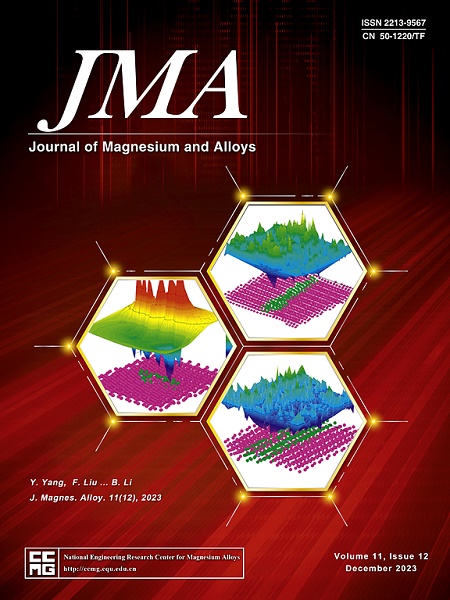Investigation of tensile twinning on texture and microstructure evolution of Mg-3Al-1Zn-1Ca alloy under in-plane shear deformation
IF 15.8
1区 材料科学
Q1 METALLURGY & METALLURGICAL ENGINEERING
引用次数: 0
Abstract
The evolution of microstructure and texture in Mg-3Al-1Zn-1Ca alloy sheets subjected to in-plane shear (IPS) loading was investigated using experimental techniques and viscoplastic self-consistent (VPSC) modeling. The specimens were deformed under varying degrees of IPS strain (γ₁₂ = 0.05, 0.10, and 0.15) using a customized jig. Electron backscatter diffraction (EBSD) observations revealed profuse tensile twinning (TTW) even at an IPS strain of 0.05, with its intensity continuously increased as the IPS strain increased. The TTWs progressively engulfed parent grains with increasing shear strain, evolving into an unusual deformation twin morphology. Furthermore, VPSC model predictions confirmed basal slip as the dominant deformation mode at low IPS strains, transitioning to prismatic slip dominance at higher IPS strains. The activity of the TTW mode was significantly higher during the initial stages of IPS strain and saturated to lower values at higher strains. VPSC simulation results also indicated preferential shear accumulation on a single twin system, explaining the phenomenon of a single twin variant engulfing a parent grain. Additionally, the influence of individual slip and twin modes on texture evolution was evaluated through orientation tracking of representative grains at various shear strain increments using VPSC simulation. The simulation results quantitatively highlighted the activities of basal slip, prismatic slip, and tensile twinning, establishing a correlation between texture evolution and the underlying deformation mechanisms.


面内剪切变形对Mg-3Al-1Zn-1Ca合金织构和组织演变的拉伸孪晶研究
采用实验技术和粘塑性自一致(VPSC)模型研究了Mg-3Al-1Zn-1Ca合金板材在面内剪切(IPS)加载下的组织和织构演变。使用定制的夹具在不同程度的IPS应变(γ₁₂= 0.05,0.10和0.15)下对试件进行变形。电子背散射衍射(EBSD)结果显示,即使在IPS应变为0.05时,拉伸孪晶(TTW)也大量出现,且强度随IPS应变的增加而不断增加。随着剪切应变的增加,TTWs逐渐吞没母晶,演变成一种不寻常的变形孪晶形态。此外,VPSC模型预测证实,在低IPS应变下,基底滑移是主要的变形模式,在高IPS应变下,以棱柱滑移为主。在IPS菌株的初始阶段,TTW模式的活性显著升高,在较高的菌株时,TTW模式的活性趋于饱和。VPSC模拟结果还显示了单孪晶系统的优先剪切积累,解释了单孪晶变体吞噬母晶的现象。此外,利用VPSC模拟,通过对不同剪切应变增量下代表性晶粒的取向跟踪,评估了单个滑移模式和孪晶模式对织构演化的影响。模拟结果定量地强调了基底滑移、棱柱滑移和拉伸孪晶的活动,建立了纹理演变与潜在变形机制之间的相关性。
本文章由计算机程序翻译,如有差异,请以英文原文为准。
求助全文
约1分钟内获得全文
求助全文
来源期刊

Journal of Magnesium and Alloys
Engineering-Mechanics of Materials
CiteScore
20.20
自引率
14.80%
发文量
52
审稿时长
59 days
期刊介绍:
The Journal of Magnesium and Alloys serves as a global platform for both theoretical and experimental studies in magnesium science and engineering. It welcomes submissions investigating various scientific and engineering factors impacting the metallurgy, processing, microstructure, properties, and applications of magnesium and alloys. The journal covers all aspects of magnesium and alloy research, including raw materials, alloy casting, extrusion and deformation, corrosion and surface treatment, joining and machining, simulation and modeling, microstructure evolution and mechanical properties, new alloy development, magnesium-based composites, bio-materials and energy materials, applications, and recycling.
 求助内容:
求助内容: 应助结果提醒方式:
应助结果提醒方式:


